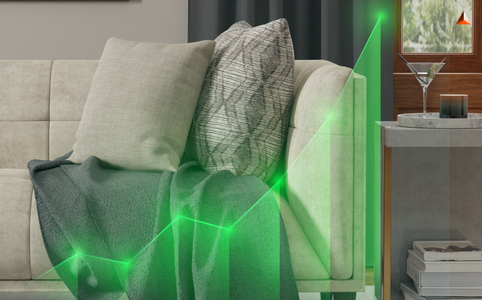3D product visualization is no longer just a “nice-to-have.” Design reviews—especially in high-stakes B2B environments—are now a core part of accelerating decisions, cutting physical prototyping costs, and ensuring your product vision translates across departments. But here’s the thing most design teams (and even senior decision-makers) learn the hard way:
Great 3D visuals don’t automatically lead to great reviews.
I’ve worked closely with product marketers, industrial designers, and visual merchandisers across industries. And if there’s one consistent theme I’ve seen, it's this: when 3D visualization is rushed, misaligned, or overly complex, the review process suffers. Not because the tech failed—but because the approach wasn’t right.
In this guide, I’ll walk you through the most common pitfalls in 3D product visualization during design reviews—along with proven strategies to avoid them.
Get the latest updates straight to your inbox.
By clicking sign up you'll receive occasional emails from imagine.io. You always have the choice to unsubscribe within every email you receive.
Delaying 3D Visualization Limits Collaboration and Speed
The Pitfall:
One of the biggest missteps is treating 3D as a “last-mile” deliverable—a sleek, polished render that gets plugged in at the end of the process. Teams often bring in 3D only when everything else is done and expect it to magically tie everything together. But by that point, it's too late for meaningful feedback.
Why it Matters:
Design reviews are meant to be iterative. When 3D visuals are introduced only at the end, feedback from stakeholders—marketing, manufacturing, sales—often comes too late or requires expensive revisions. This turns what should be a collaborative review into a frustrating backtrack exercise. Stakeholders may even hesitate to comment because the visual looks “finished.”
How to Avoid it:
Bring 3D into the process early. Start with low- or mid-fidelity 3D mockups that evolve with feedback over time. This invites early collaboration and prevents last-minute overhauls. Platforms like imagine.io allow quick iterations without bottlenecks, empowering teams to update visuals on the fly without depending on external vendors or CAD experts.
Relying Solely on AI for Visualization
The Pitfall:
In a rush to cut costs or speed things up, many teams turn to AI-generated images as a standalone solution. While AI can quickly create visually appealing renders or lifestyle scenes, it lacks the functional depth needed for serious design reviews.
Why it Matters:
AI tools are great at generating static visuals from single perspectives—but that’s where it ends. You can’t rotate the product, explore variations, or simulate real-world lighting and material changes. This limitation prevents stakeholders from interacting with the product meaningfully, leading to surface-level decisions and missed insights.
How to Avoid it:
Use AI to support your 3D workflow, not replace it. imagine.io integrates AI-powered scene styling and object placement, but the core of the experience remains interactive 3D and AR. You get the speed and creativity of AI, paired with the depth and flexibility of true 3D. This ensures you’re not sacrificing product understanding for visual shortcuts.
Overlooking Visual Context
The Pitfall:
A perfectly lit, isolated render on a white background might look clean, but it strips away any real-world reference. Stakeholders are left guessing about how the product fits into its environment. The result? Misalignment on scale, usability, and visual appeal.
Why it Matters:
Design reviews aren't about making things look pretty—they’re about evaluating whether a product is ready for market. Without context—like how a lamp looks on a nightstand or how a chair fits in a workspace—stakeholders can’t make informed decisions. This often leads to unexpected feedback later in the cycle, forcing teams to rework what they thought was final.
How to Avoid it:
Add contextual environments to your visualizations—whether it’s a lifestyle setting, a use-case scenario, or a room layout. Also consider exploded views or in-use animations. Modern tools like imagine.io allow you to place your 3D assets into ready-made or custom visual backdrops to communicate product fit and function clearly to all reviewers.
Failing to Enable Interaction
The Pitfall:
Relying solely on static images—or even pre-recorded videos—can limit your team’s ability to thoroughly review a design. These visuals look good on paper, but they don’t allow users to engage, explore, or ask “what if?”
Why it Matters:
Interactive engagement is essential for catching issues early. If reviewers can’t zoom in on a joint, rotate a model to view the underside, or toggle between fabric options, you're not giving them the full picture. This leads to surface-level approvals, followed by deeper concerns popping up in production—when changes are expensive and time-consuming.
How to Avoid it:
Incorporate interactive 3D viewers and configurators into your review flow. Platforms like imagine.io allow users to explore a product from every angle, try out variants, and simulate disassembly. These capabilities foster richer discussions and lead to faster, more confident approvals.
Neglecting Version Control and Feedback Integration
The Pitfall:
In the absence of a centralized system, feedback ends up scattered across email threads, Slack messages, or annotated screenshots—often referencing different versions of the same asset. Confusion reigns, and teams waste time figuring out which version is “final.”
Why it Matters:
Without clear version control and feedback history, it becomes almost impossible to move forward with confidence. Mistakes slip through the cracks, decisions get delayed, and the wrong files can easily make their way into production.
How to Avoid it:
Use a platform with built-in version tracking and visual collaboration. Stakeholders should be able to view, comment on, and compare different versions—all in one place. imagine.io enables centralized commenting on live 3D assets, ensuring feedback is captured in context and changes are documented with full traceability.
Assuming All Stakeholders Understand 3D the Same Way
The Pitfall:
Designers are fluent in CAD and spatial thinking. Executives, marketers, and buyers often are not. Assuming everyone interprets 3D renders the same way creates a knowledge gap that can derail design reviews.
Why it Matters:
If stakeholders feel overwhelmed by technical jargon, complex visuals, or unfamiliar interfaces, they may disengage—or worse, give uninformed approvals. This leads to disconnects between design intent and business expectations.
How to Avoid it:
Make your visuals accessible to non-designers. That means annotated visuals, intuitive UIs, and simplified language. imagine.io is built to bridge that gap—with a UI that caters to both creatives and decision-makers. Everyone sees what they need to see, clearly and confidently.
Skipping Mobile and Cross-Device Optimization
The Pitfall:
Design teams often test and present 3D assets on high-end machines. But stakeholders—especially executives—are reviewing from phones, tablets, or lightweight laptops. If your visuals aren’t optimized for all devices, the experience suffers.
Why it Matters:
If someone opens a render and it lags, doesn’t load, or crashes their browser, they’re unlikely to continue the review. You lose momentum, feedback, and sometimes the stakeholder’s attention altogether.
How to Avoid it:
Choose a cloud-based 3D visualization platform that ensures your visuals are instantly accessible from any device—without needing large file downloads. imagine.io’s viewer is optimized for mobile, tablet, desktop, and even AR—enabling true anywhere-anytime collaboration.
Not Measuring the ROI of Your Visualization Workflow
The Pitfall:
Teams often treat 3D visualization as a creative tool, not a measurable business driver. If you’re not tracking how it improves speed, accuracy, or cost-efficiency, leadership may start questioning the investment.
Why it Matters:
3D visualization has tangible benefits—reduced prototyping costs, faster time to market, fewer revision cycles. But without data, you can’t prove those benefits to decision-makers, which limits further adoption and investment.
How to Avoid it:
Track relevant metrics: how many prototypes were replaced by 3D, how long it takes from design to approval, and how many hours were saved in feedback loops. imagine.io provides centralized analytics that help teams visualize these impacts and build a strong case for ongoing use.
Final Thoughts: Think Beyond Pretty Renders
3D visualization isn’t just about making your product look good. It’s about getting the right feedback, making faster decisions, and keeping teams aligned throughout the development process. But to get those benefits, your workflow needs to be intentional, inclusive, and well-optimized.
And while AI plays an important role, it’s not a substitute for robust 3D design reviews. Combining AI with interactive visualization is the key to a future-ready product development pipeline. If you’re still relying on PDFs, static renders, or standalone AI images, you’re leaving clarity—and efficiency—on the table. Let’s change that.
Book a demo and see how imagine.io helps you bring together AI, 3D, and AR into one seamless, scalable visualization platform.


.png?width=1300&height=809&name=Internal%20-%20Delaying%203D%20Visualization%20Limits%20Collaboration%20and%20Speed%20(1).png)


.gif?width=1296&height=1296&name=Untitled%20design%20(8).gif)




.png?width=500&name=How%20to%20Add%20a%203D%20Product%20Configurator%20to%20Your%20WordPress%20Website%20(Complete%20B2B%20Guide).png)
















%20(1).png?width=500&name=Why%20Exploded%20Mattress%20Views%20Matter%20(And%20How%20to%20Generate%20Them)%20(1).png)
.png?width=500&name=Best%20Shopify%20Product%20Configurator_%20How%20to%20Choose%20the%20Right%20One%20(2).png)
.png?width=500&name=Why%20Exploded%20Mattress%20Views%20Matter%20(And%20How%20to%20Generate%20Them).png)



.png?width=500&name=Best%20Shopify%20Product%20Configurator_%20How%20to%20Choose%20the%20Right%20One%20(1).png)







.png?width=500&name=How%203D%20Rendering%20Can%20Make%20or%20Break%20Your%20Industrial%20Design%20Pitch%20(1).png)








%20with%20Digital%20Twins%20and%203D%20Visualization.png?width=500&name=Optimizing%20Your%20Digital%20Asset%20Management%20(DAM)%20with%20Digital%20Twins%20and%203D%20Visualization.png)




.png?width=500&name=Styling%20Home%20Decor%20for%202025_%20From%20Global%20Influences%20to%20Playful%20Personalization%20(1).png)
